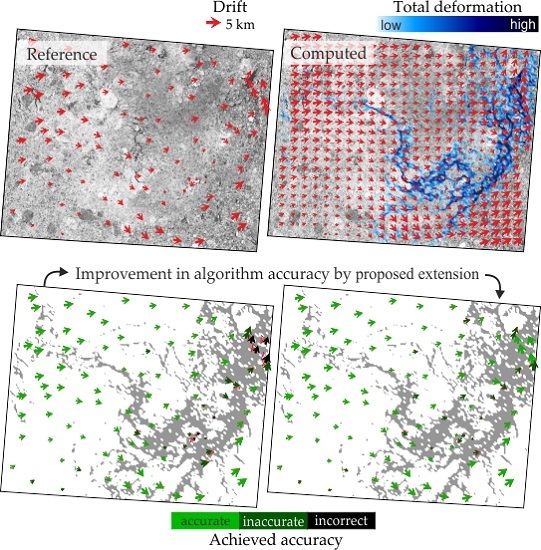A Method to Improve High-Resolution Sea Ice Drift Retrievals in the Presence of Deformation Zones
Abstract
:1. Introduction
2. Materials and Methods
2.1. Reliability Assessment
2.2. Detection of LDFs and Outliers
2.2.1. Spatial Distribution of Discontinuities and Identification of LDFs
2.2.2. Segmentation by LDFs
2.2.3. Adapted Outlier Detection
2.3. Validation
2.4. Calculation of Sea Ice Deformation Parameters
2.5. Test Sites, SAR and Reference Data
3. Results
3.1. Drift Retrievals and Algorithm Accuracy
3.2. Computational Efficiency
4. Discussion
5. Conclusions
Acknowledgments
Author Contributions
Conflicts of Interest
References
- Hollands, T.; Dierking, W. Performance of a multiscale correlation algorithm for the estimation of sea-ice drift from SAR images: Initial results. Ann. Glaciol. 2011, 52, 311–317. [Google Scholar] [CrossRef]
- Holt, B.; Rothrock, D.A.; Kwok, R. Determination of sea ice motion from satellite images. In Microwave Remote Sensing of Sea Ice; American Geophysical Union: Washington, DC, USA, 1992; pp. 343–354. [Google Scholar]
- Pedersen, L.T.; Saldo, R.; Fenger-Nielsen, R. Sentinel-1 results: Sea ice operational monitoring. In Proceedings of the 2015 IEEE International Geoscience and Remote Sensing Symposium (IGARSS), Milan, Italy, 26–31 July 2015; pp. 2828–2831. [Google Scholar]
- Dierking, W.; Dall, J. Sea-Ice Deformation State from Synthetic Aperture Radar Imagery—Part I: Comparison of C- and L-Band and Different Polarization. IEEE Trans. Geosci. Remote Sens. 2007, 45, 3610–3622. [Google Scholar] [CrossRef]
- Tin, T.; Jeffries, M.O. Morphology of deformed first-year sea ice features in the Southern Ocean. Cold Reg. Sci. Technol. 2003, 36, 141–163. [Google Scholar] [CrossRef]
- Thomas, M.; Geiger, C.A.; Kambhamettu, C. High resolution (400 m) motion characterization of sea ice using ERS-1 SAR imagery. Cold Reg. Sci. Technol. 2008, 52, 207–223. [Google Scholar] [CrossRef]
- Reddy, B.S.; Chatterji, B.N. An FFT-based technique for translation, rotation, and scale-invariant image registration. IEEE Trans. Image Process. 1996, 5, 1266–1271. [Google Scholar] [CrossRef] [PubMed]
- Hollands, T.; Linow, S.; Dierking, W. Reliability Measures for Sea Ice Motion Retrieval from Synthetic Aperture Radar Images. IEEE J. Sel. Top. Appl. Earth Obs. Remote Sens. 2015, 8, 67–75. [Google Scholar] [CrossRef]
- Lavergne, T.; Eastwood, S.; Teffah, Z.; Schyberg, H.; Breivik, L.-A. Sea ice motion from low-resolution satellite sensors: An alternative method and its validation in the Arctic. J. Geophys. Res. 2010, 115, C10032. [Google Scholar] [CrossRef]
- Marsan, D.; Stern, H.; Lindsay, R.; Weiss, J. Scale Dependence and Localization of the Deformation of Arctic Sea Ice. Phys. Rev. Lett. 2004, 93, 178501. [Google Scholar] [CrossRef] [PubMed]
- Huber, P.J.; Ronchetti, E. Robust Statistics; John Wiley & Sons: Hoboken, NJ, USA, 2009. [Google Scholar]
- Leys, C.; Ley, C.; Klein, O.; Bernard, P.; Licata, L. Detecting outliers: Do not use standard deviation around the mean, use absolute deviation around the median. J. Exp. Soc. Psychol. 2013, 49, 764–766. [Google Scholar] [CrossRef]
- Thomas, M.V. Analysis of Large Magnitude Discontinuous Non-Rigid Motion. Ph.D. Thesis, University of Delaware Newark, Newark, DE, USA, 2008. [Google Scholar]
- Thorndike, A.S.; Colony, R. Sea ice motion in response to geostrophic winds. J. Geophys. Res. 1982, 87, 5845. [Google Scholar] [CrossRef]
- Lindsay, R.W.; Stern, H.L. The RADARSAT Geophysical Processor System: Quality of Sea Ice Trajectory and Deformation Estimates. J. Atmos. Ocean. Technol. 2003, 20, 1333–1347. [Google Scholar] [CrossRef]
- Komarov, A.S.; Barber, D.G. Sea Ice Motion Tracking From Sequential Dual-Polarization RADARSAT-2 Images. IEEE Trans. Geosci. Remote Sens. 2014, 52, 121–136. [Google Scholar] [CrossRef]
- Muckenhuber, S.; Korosov, A.A.; Sandven, S. Open-source feature-tracking algorithm for sea ice drift retrieval from Sentinel-1 SAR imagery. Cryosphere 2016, 10, 913–925. [Google Scholar] [CrossRef]
- Hutchings, J.K.; Roberts, A.; Geiger, C.A.; Richter-Menge, J. Spatial and temporal characterization of sea-ice deformation. Ann. Glaciol. 2011, 52, 360–368. [Google Scholar] [CrossRef]
- Rampal, P.; Weiss, J.; Marsan, D.; Lindsay, R.; Stern, H. Scaling properties of sea ice deformation from buoy dispersion analysis. J. Geophys. Res. 2008, 113, C03002. [Google Scholar] [CrossRef]
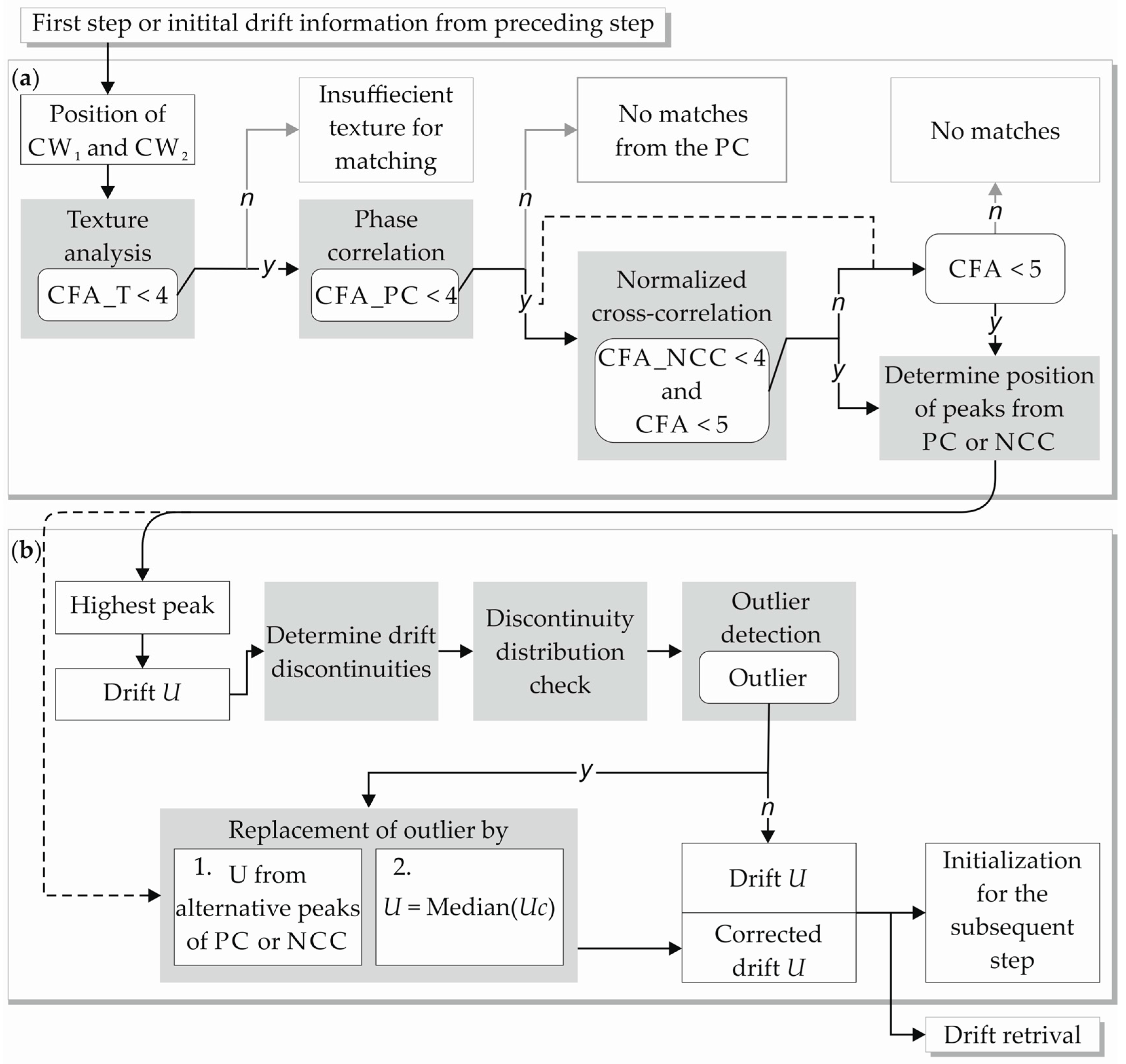


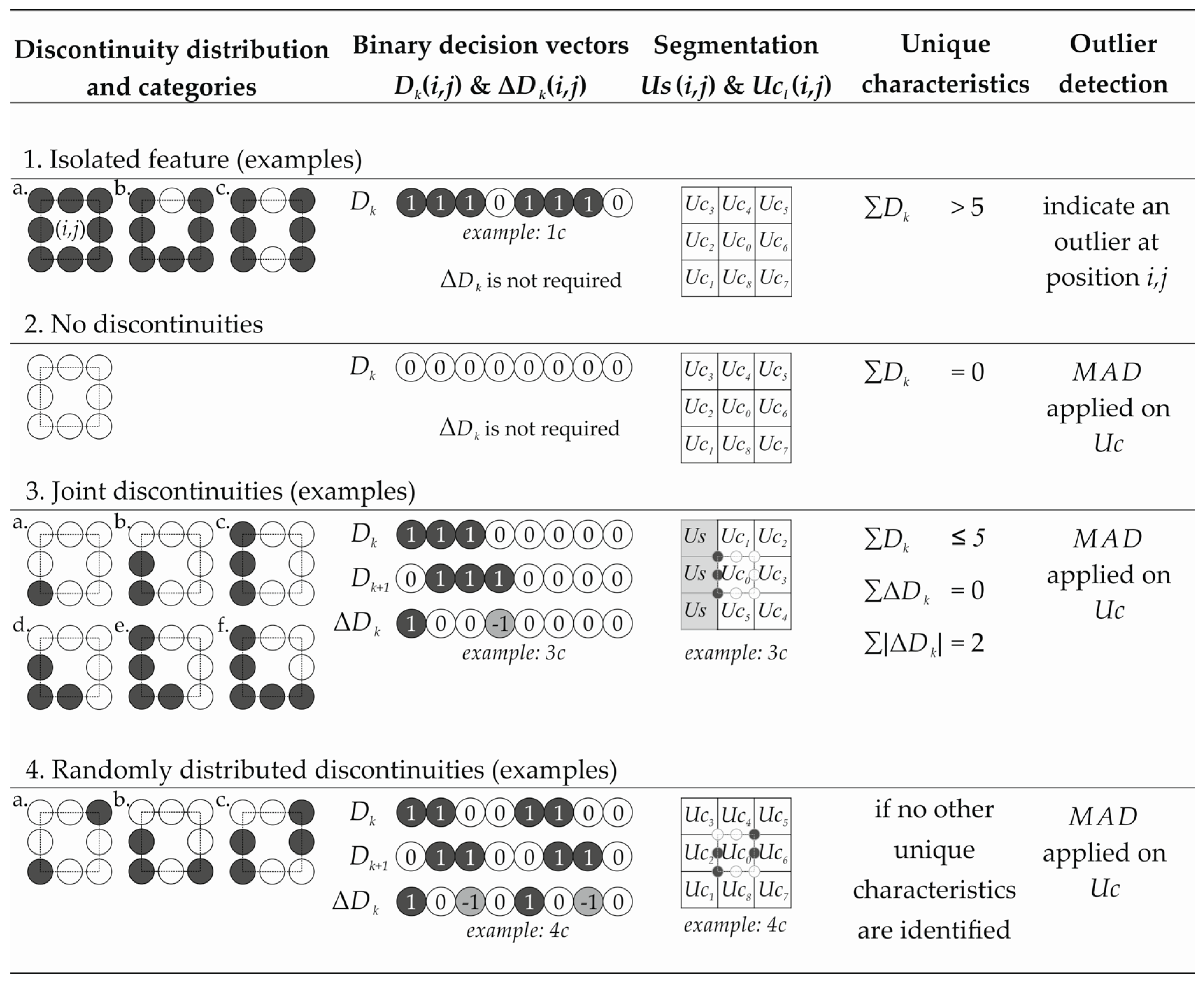

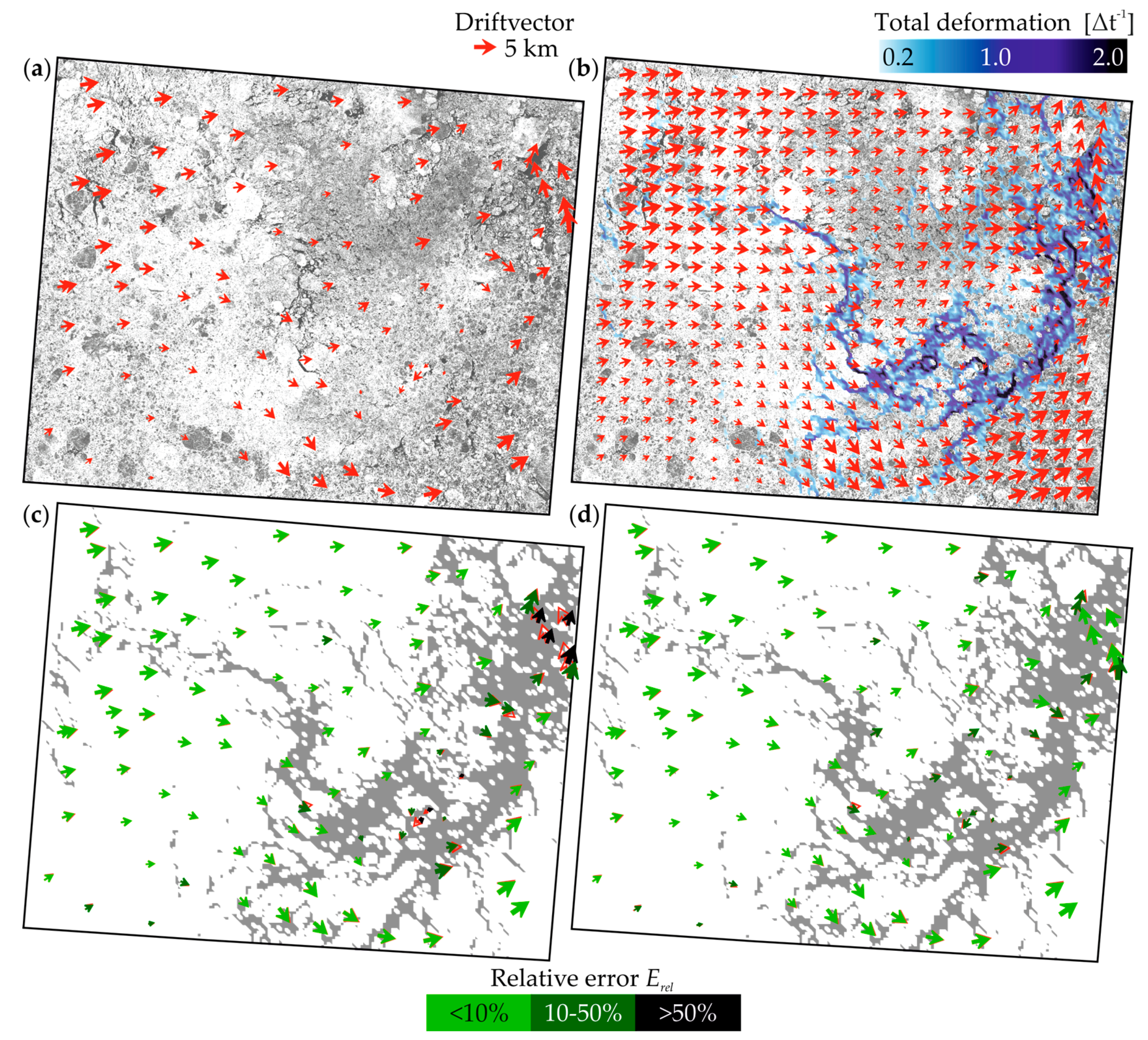
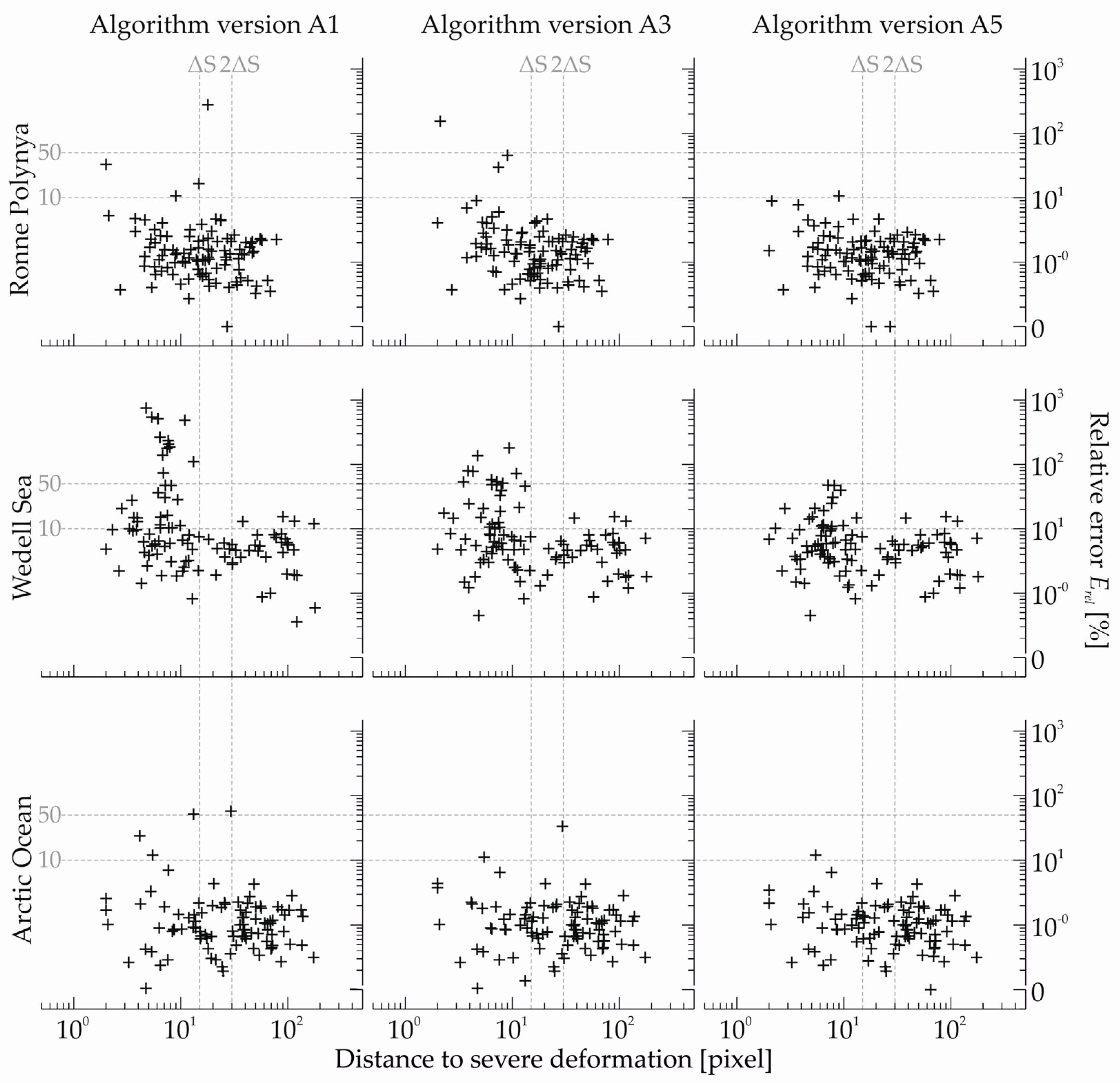

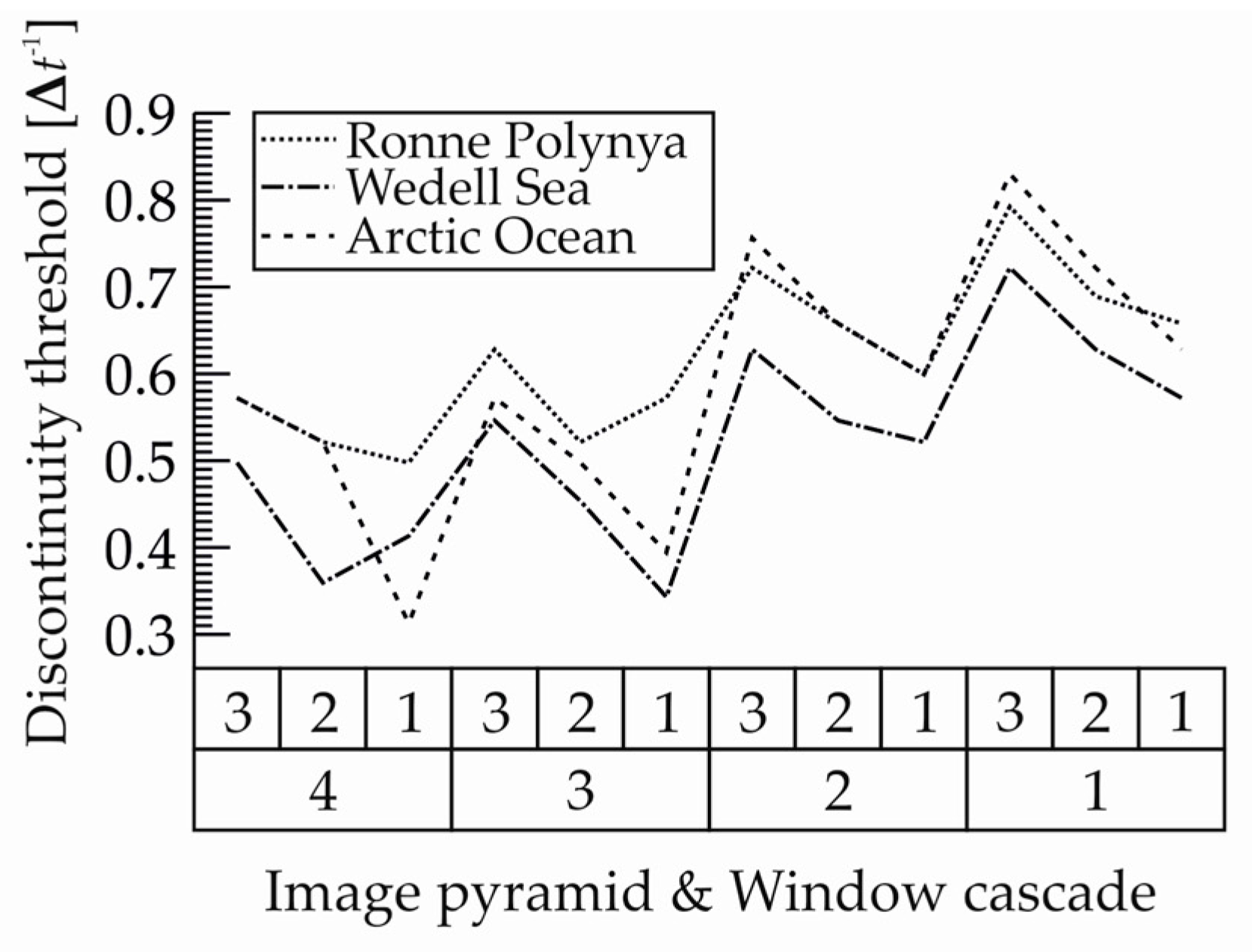
| Confidence Factor | Abbreviations | Threshold/Range | Value |
|---|---|---|---|
| Texture_CFA (see [8]) | CFA_T | 0–4 | |
| Variance-to-squared-mean-ratio | VMR | <0.5 | +1 |
| Mean intensity gradient | MIT | <1.7 | +1 |
| Mean gradient slope | MGS | <0.35 | +1 |
| Intensity threshold | IT | >−3 dB | +1 |
| Correlation_CFA (obtained from NCC or PC) | CFA_NCC or CFA_PC | 0–4 | |
| NCC (coefficient and confidence interval) | NCCC | <0.1 | =4 |
| 0.1–0.2 | =3 | ||
| 0.2–0.4 | =2 | ||
| 0.4–0.8 | =1 | ||
| >0.8 | =0 | ||
| NCCI | >0.2 | =4 | |
| PC (Relative peak magnitude) | RPM | <1.58 | =4 |
| 1.58–2.51 | =3 | ||
| 2.51–3.98 | =2 | ||
| 3.98–6.31 | =1 | ||
| >6.31 | =0 | ||
| Confidence factor | CFA | 0–8 |
| Methods | Algorithm Version | ||||
|---|---|---|---|---|---|
| A1 | A2 | A3 | A4 | A5 | |
| Median filter | X | X | |||
| Intrinsic use of the reliability assessment | X | X | X | ||
| Outlier detection using MAD | X | X | |||
| Preceding window segmentation by a identified LDF | X | ||||
| Region | Ronne Polynya | Weddell Sea | Arctic Ocean |
|---|---|---|---|
| Extent of the overlap (N/S) | 74°S/77°S | 73.4°S/75°S | 85°N/80.5°N |
| Extent of the overlap (W/E) | 64°W/49°W | 39°W/33.5°W | 17°E/48.5°E |
| Overlapping area | 60,000 km2 | 14,000 km2 | 100,000 km2 |
| Satellite | Envisat ASAR | TerraSAR-X | Sentinel-1 |
| Reprojection | Polar Stereographic | Polar Stereographic | Polar Stereographic |
| Band & mode | C, Wide Swath | X, ScanSAR | C, Extra Wide Swath |
| Used resolution | 150 m | 50 m | 80 m |
| Date | 22/23 February 2008 | 14/15 February 2014 | 1/2 January 2015 |
| Season | Summer | Summer | Winter |
| Acquisition time gap (Δt) | 23:30 h | 6:13 h | 24:41 h |
| Drift grid spacing (ΔS) | 2250 m | 750 m | 1200 m |
| Region | Ronne Polynya | Weddell Sea | Arctic Ocean |
|---|---|---|---|
| Mean absolute drift [ms−1] | 0.094 | 0.036 | 0.231 |
| Mean total deformation rate [s−1] | 4.007 × 10−6 | 10.616 × 10−6 | 1.981 × 10−6 |
| Mean divergence rate [s−1] | −0.191 × 10−6 | −0.113 × 10−6 | −0.351 × 10−6 |
| Mean shear rate [s−1] | 3.287 × 10−6 | 9.003 × 10−6 | 1.725 × 10−6 |
| Test Site | Algorithm Accuracy Benchmarks | |||||||||
|---|---|---|---|---|---|---|---|---|---|---|
| B1abs | B1rel | B2abs | B2rel | B3 | B4 | B5 | ||||
| [pixel] | [m] | [%] | [pixel | m] | [%] | [°] | ||||
| Ronne Polynya Envisat ASAR 22/23 February 2008 | A1 | 3.89 | 584 | 4.8 | 24.10 | 3616 | 27.9 | 2.40 | 4 | 1 |
| A2 | 2.21 | 331 | 4.1 | 5.08 | 763 | 15.1 | 1.31 | 4 | 1 | |
| A3 | 1.84 | 276 | 3.8 | 4.15 | 622 | 14.4 | 1.17 | 3 | 1 | |
| A4 | 1.19 | 179 | 1.8 | 1.54 | 232 | 2.5 | 0.65 | 1 | 0 | |
| A5 | 1.16 | 174 | 1.7 | 1.48 | 222 | 2.4 | 0.60 | 1 | 0 | |
| Weddell Sea TerraSAR-X 14/15 February 2014 | A1 | 30.35 | 1518 | 48.0 | 90.54 | 4527 | 124.3 | 20.39 | 37 | 15 |
| A2 | 13.54 | 677 | 20.2 | 28.03 | 1401 | 36.5 | 13.84 | 37 | 14 | |
| A3 | 8.60 | 430 | 14.9 | 15.71 | 786 | 32.3 | 7.58 | 29 | 11 | |
| A4 | 5.05 | 253 | 11.4 | 7.76 | 388 | 31.7 | 5.55 | 25 | 3 | |
| A5 | 4.13 | 207 | 7.7 | 5.64 | 282 | 11.5 | 3.08 | 21 | 0 | |
| Arctic Ocean Sentinel-1 01/02 January 2015 | A1 | 6.97 | 558 | 2.6 | 25.05 | 2004 | 8.1 | 1.08 | 4 | 2 |
| A2 | 5.64 | 451 | 2.0 | 23.87 | 1909 | 6.4 | 0.62 | 2 | 1 | |
| A3 | 4.20 | 337 | 1.7 | 12.10 | 966 | 3.9 | 0.74 | 2 | 0 | |
| A4 | 3.44 | 276 | 1.5 | 5.52 | 441 | 2.2 | 0.58 | 1 | 0 | |
| A5 | 3.08 | 246 | 1.3 | 4.04 | 323 | 2.0 | 0.54 | 1 | 0 | |
| Test Site | Number Drift Vectors | Computing Time | |||
|---|---|---|---|---|---|
| Total [s] | per 100 Vectors [s] | ||||
| A1 | A5 | A1 | A5 | ||
| Ronne Polynya | 14,000 | 170 | 210 | 1.2 | 1.5 |
| Weddell Sea | 29,000 | 580 | 460 | 2.0 | 1.6 |
| Arctic Ocean | 77,000 | 1000 | 1200 | 1.3 | 1.5 |
© 2017 by the authors. Licensee MDPI, Basel, Switzerland. This article is an open access article distributed under the terms and conditions of the Creative Commons Attribution (CC BY) license (http://creativecommons.org/licenses/by/4.0/).
Share and Cite
Griebel, J.; Dierking, W. A Method to Improve High-Resolution Sea Ice Drift Retrievals in the Presence of Deformation Zones. Remote Sens. 2017, 9, 718. https://doi.org/10.3390/rs9070718
Griebel J, Dierking W. A Method to Improve High-Resolution Sea Ice Drift Retrievals in the Presence of Deformation Zones. Remote Sensing. 2017; 9(7):718. https://doi.org/10.3390/rs9070718
Chicago/Turabian StyleGriebel, Jakob, and Wolfgang Dierking. 2017. "A Method to Improve High-Resolution Sea Ice Drift Retrievals in the Presence of Deformation Zones" Remote Sensing 9, no. 7: 718. https://doi.org/10.3390/rs9070718



